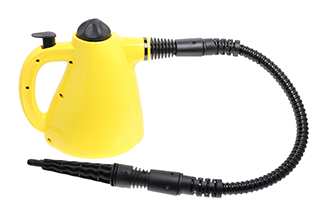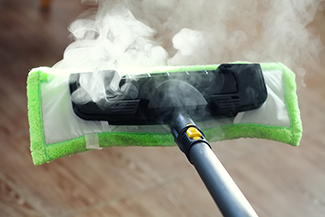Things Are Getting Steamy!
Things Are Getting Steamy!
If you are seeking a cleaning system that is all-natural and eco-friendly, consider steam cleaning. Steam cleaners do not leave an odor -- just a fresh clean smell that is germ and chemical-free. They are useful for deep cleaning and sanitizing with little effort involved.
What is Steam & How Does It Work for Cleaning
 When water is heated, it evaporates. It turns into water vapor and expands. At 100℃ it boils, evaporates rapidly. At boiling point, the invisible gas of steam is created. The steam's molecules penetrate a surface's pores to force out dirt, grease, grime, and other stain-causing substances. When done correctly, steam cleaning can quickly kill 99.99% of germs and bacteria – without the use of chemical-based disinfectants.
When water is heated, it evaporates. It turns into water vapor and expands. At 100℃ it boils, evaporates rapidly. At boiling point, the invisible gas of steam is created. The steam's molecules penetrate a surface's pores to force out dirt, grease, grime, and other stain-causing substances. When done correctly, steam cleaning can quickly kill 99.99% of germs and bacteria – without the use of chemical-based disinfectants.
Items & Surfaces You Can Safely and Effectively Steam Clean
- ceramic or porcelain tile and grout
- glass shower doors and tracks
- patio door tracks
- metal pet cages and bowls
- stovetops and grills
- patio furniture
- countertops, sinks, and plumbing fixtures
- mattresses and bedding
- drapes
- ceiling fans
- garden tools
- precious gemstones
Depending on the type of steamer you use, you may need special attachments for specific tasks.
Items You Do NOT Want to Steam Clean
The results of steam cleaning these surfaces will leave you steamed.
- unsealed, polished, waxed, or freshly painted surfaces
- finished wood -- unless it has a polyurethane-base and can withstand heat and brief moisture.
- antiques -- most have varnish or shellac finishes that will dull the luster or sheen and the finish could blister
- nylon mesh window screens
- laminate flooring -- the fiberboard core can be ruined by moisture that seeps through the seams between planks
- musical instruments with a unique wooden finish
Buying a Steam Cleaner
There are several types of steam cleaners for home use. When selecting a cleaner, buy only certified electrical appliances that carry approval ratings from an official certification agency, such as Underwriters Laboratories (UL).
Handheld steam cleaners

Small, light, portable, and low-priced (starting at under $80), handheld steam cleaners are easy to use and store.
Pros:
- extremely useful for cleaning stovetop nobs, crevices between the stove and countertop, seams along the countertop
- removing small stains from carpets.
Cons:
- not designed for cleaning floors or for large surfaces
- has a small tank that offers limited operating time.
Steam Mops
Designed for daily floor cleaning, steam mops are light and easy to handle. Similar to a broom, but with greater hygiene.
Pros:
- models available as low as $35
- ready to use in a few seconds
- light and easy to use
- perfect for cleaning and sanitizing floors
- takes up very little space
Cons:
- difficult to clean corners or other hard to reach areas
- may not remove stubborn dirt
- may require a specific accessory to clean carpets
- the small tank may require frequent refills
Cylinder Steam Cleaners

Similar to a vacuum cleaner, their size is determined by the boiler that generates high-pressure steam.
Some models may be lighter and more compact can be strapped on during cleaning.
Pros:
- versatile -- good for cleaning and sanitizing the entire home in one cleaning project
- large tank so you don't have to stop cleaning to water
- many accessories available
- effectively removes stubborn dirt, stains, and marks
- wide price range to fit any budget: from $99 to $659
Cons:
- can be more difficult to handle than steam mops or handheld steam cleaners
Steam and vacuuming integrated systems
Ideal for maximum cleanliness in minimum time, this design combines the effectiveness of cylinder steam cleaners with a vacuum function - creating a single device able to vacuum, clean, and sanitize every washable surface in the house, without using chemical detergents.
Pros:
- no need for a separate traditional vacuum cleaner
- versatile and capable of cleaning and sanitizing the entire home
- combined steam and suction action
- heats up quickly
- large tank
- many accessories available
- effectively removes stubborn dirt, stains, and marks
Cons:
- prices start around $250
- needs more room to store
A note about tank size: The more water the tanks holds, the longer you can clean before stopping to refill and reheat. Machines with a "continuous fill" come with a backup tank to keep you cleaning longer.
When selecting a steam cleaner, look for good customer service, a strong warranty, and long product life.
Cleaning Tips
- Use distilled water to prevent mineral buildup in the cleaner and on surfaces.
- Do not use a garment steamer on delicate fabrics, on colors that could run, or on items that cannot take heat and steam.
- When using tools with cloth pockets or covers, clean the items that are the least dirty first.
- Change the cloth covers on steaming tools when they become soiled. Otherwise, you will be smearing dirt over a surface rather than actually cleaning it.
- Don't store damp cloths. They will grow or mold.
- Have all the attachments close at hand.
- Sweep and vacuum before steam cleaning.
- Clean top to bottom on door frames and thresholds.
- Keep attachments stored with the steamer bottle for quick retrieval.
- Do not linger on sealed wood, painted surfaces, or any area that has a paper, wood, plywood, or cardboard composite construction. On areas you are not sure about, test a small area first.
Caution: Remember, you are using boiling water.
- Read the cleaner's manual first and use it for what it is designed to do.
- Wear closed-toe shoes.
- Use a portable steamer only on surfaces and materials that are sealed and can take high heat and moisture.
- Be aware of temperature variations that could cause glass or porcelain to break. For example, do not steam-clean a glass windowpane on a very cold day.
- Ensure that accessory tools are properly and securely attached.
- Steam continues to exhaust for several seconds after the trigger is released. Do not direct at plants or other items that cannot take moisture or heat.
- Unplug before refilling with water and before changing attachments.
- Use care when putting down a hot tool.
Podcast
Home Maintenance Calendar To-Do: #SteamClean
###
RELATED CONTENT:
- Blog: Five Ways To Cook Up Excitement At Your Next Barbecue
- Blog: Seven Ways To Get Tough On Dust And Dirt For Spring
- Blog: 12 Simple Spring Storage Hacks
- DIY Q&A: What Are Rosie's Recipes for Homemade Green Cleaning Products
- DIY Q&A: How Do I clean Those Unique Surfaces?
- DIY Q&A: Rosie's Top 10 Things Homeowners Do Wrong
- Podcast: Swimming Pools, Landscaping Tips, & Your Home Repairs
